Although the Andean country is visited by its extraordinary Inca historic legacies like Machu Picchu, its millennial mysteries like the Nazca Lines, or its awesome Amazon. Peru is also recognized worldwide as a good hiking country.
Thanks to its climatic synthesis that brings together almost all the world’s climates and its beautiful geographical features in the Coast, Sierra, and Jungle to take advantage of, you can enjoy its varied hiking trails along its territory. Due to these incredible landscapes, many people visiting Peru are hikers. That is why Machu Travel Peru wants to help you know the experience of hiking in Peru in all its splendor. Therefore, we show you 12 fantastic hiking routes.
Many of these hikes suit everyone, and you do not need to be a professional hiker to do them. Some of them don’t even require that much physical effort. Join us on this journey in South America.
Hiking in Peru, the 12 best top experiences
- Ausangate
- Inca Trail
- Choquequirao
- Santa Cruz
- The Vilcabamba
- Salkantay
- Laguna 69
- Humantay Lake
- Rainbow Mountain
- Huayhuash trek
- Colca Canyon
- Huchuy Qosqo
1. Ausangate
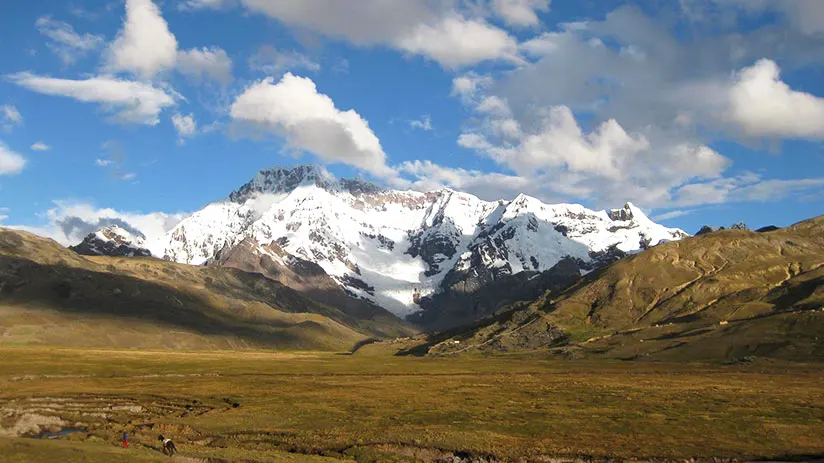
| Duration | 6 Days / 5 Nights |
| Extension | 46 km. approx. |
| Elevation | Around (6,384 m./ 20,944 ft.) |
| Difficulty | Challenging |
A. Route
Normally, it takes 6 days and 5 nights and allows you to tour the Vilcanota mountain range, appreciating colorful hills, high snows, crystalline lagoons, green pastures with hundreds of alpacas, charming valleys, and traditional Peruvian villages. Wildcats, pumas, and condors can also accompany your tour.
The path of 46 kilometers surrounds the Ausangate snow (6,384 m./ 20,944 ft.) and passes over the (4,000 m. / 13,123 ft.). The hike starts in Tinki town (2 hours from Cusco by bus) and finishes in the same town. The Tinki inhabitants consider the hike a pilgrimage to its deity Ausangate (the Incas called Snows and Mountains Apus its deities)
The weather during the tour can change drastically, from one clear and sunny day to a rainy and cloudy one, and even can snow in some zones close to the Ausangate Snowy. Three high points are crossed at more than (5,000 m. / 16,404 ft.). The highest is called Palomino Pass and is located at (5200 m/17,060 ft). Here, you’ll get awesome pictures and views of the zone and the snow.
B. Difficulty
The route is remote, straightforward, and easy to follow. It can be done without a guide, offers great views, and represents a real adventure. However, the path is rough, with steep slopes, considering the high altitude at which it is located. For all these reasons, the hike is recommendable for professional hikers with good physical condition (essential to be well acclimatized). The best time to hike Ausangate is from October to November and April, when it is relatively hot and dry.
C. Interesting points to pass
It is one of the most famous treks near Cusco, allowing you to see Vinicunca Mountain, also known as Rainbow Mountain, in its first days. In the 5º day, you can rest well in the thermal baths of Pacchanta. The Ausangate Snow and its fantastic views will be the ice on the cake on this route.
2. Inca Trail
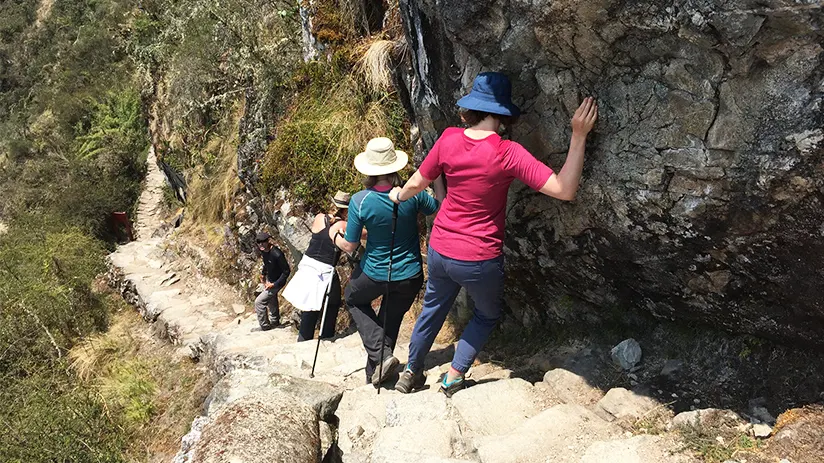
| Duration | 4 Days / 3 Nights |
| Extension | 50 kilometers or 31 miles |
| Elevation | Between (2,500 m. / 8,202 ft.) to (4,200 m. / 13,779 ft.) |
| Difficulty | Moderate |
A. Route
The Inca Trail to Machu Picchu is the most well-known hike in Peru. Being able to hike by the same footpath that the Incas toured centuries ago to get to its wonder (Machu Picchu) is priceless. Also, it is cataloged as one of the best 5 hikes worldwide, even compared with the trek to Everest base camp.
The hike lasts 4 days and 3 nights. You will start the section from the city of Cusco towards the Sacred Valley by train or bus. After, from Ollantaytambo train station, you’ll have to take a train toward Machu Picchu and get off on the 82 Km. from the railway. From this point, precisely from Piskacucho town, begin the hike of ancient inca.
The first day involves a moderate climb to the first camp zone, Wayllabamba. The climb to the Pacaymayo camp zone will be more challenging on the second day. On this day, you will pass by charming places like Llulluchapampa and Yunca Chimpa Valley.
The third day is a real challenge for trekkers, the climb will get heavier, passing sites like Runkurakay located at (3,860 m./ 12,664 ft.) until Wiñayhuayna camp zone, the last one before getting to Machu Picchu.
On the fourth day, you will slightly descend to the world’s wonder, Machu Picchu. If we notice an Inca Trail map, we’ll realize that it has 50 kilometers or 31 miles of extension, with an elevation between (2,500 m / 8,202 ft.) and (4,200 m. / 13,779 ft.)
It is definitely the best hiking in the Andean country. However, the route has a limited capacity (the Peruvian government manages it), and a ticket entrance, expended by authorized travel agencies, is necessary.
For this reason, this hike can’t be done by one’s own account and needs a travel agency. The capacity is 500 entrance tickets daily (200 tickets are for agency staff such as guides and porters and only 300 for visitors). Making a reservation of Inca Trail tickets more than 6 months in advance will be recommendable with a tour company, and don’t forget to bring your map of Machu Picchu.
B. Difficulty
The footpath is steep and high. Also, the route has some steep, slippery, rocky slopes and climbs (On its second day) If you are not acclimatized, altitude sickness will affect you. The highest point is called Warmiwañusca (Dead Woman Pass in the Quechua language) with, (4,215 m. / 13,828 ft.). You will have a great view of Vilcanota Valley from there.
C. Interesting points to pass
The route connects several archaeological sites linked to Runcurakay, Sayacmarca, Phuyucptamarca, Wiñaywayna, and finally Machu Picchu.
The most remarkable are the Patallacta ruins, which include 100 Inca buildings, terraces, and a sanctuary for high ceremonies.
Phuyupatamarca or cloud town is characterized by its irrigation systems, terraces, and ceremonial baths used by Incas priests. Also, it was a place of worship to the water.
Wiñay Wayna, (Forever Young Town) is a group of edifications destined for production (terraces) and an administrative center of food guarded in its storage (Tambos)
3. Choquequirao
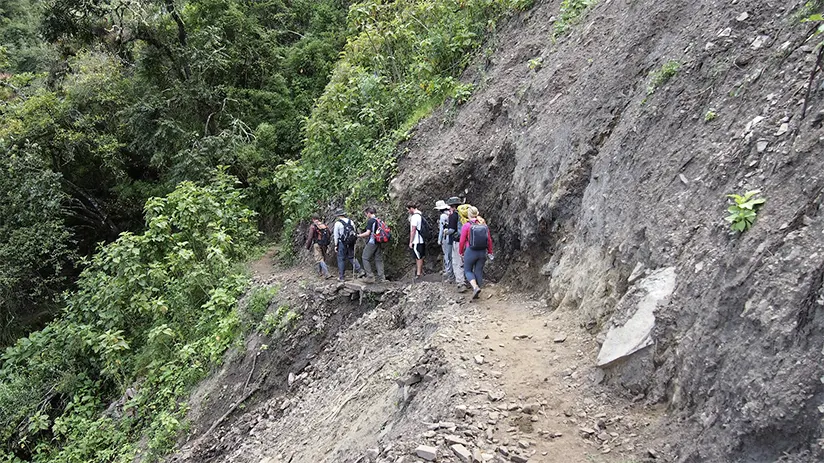
| Duration | 5 Days / 4 Nights |
| Extension | 60 kilometers or 37 miles |
| Elevation | (3,030 m. / 9,940 ft.) |
| Difficulty | Challenging |
A. Route
It is said that Choquequirao is the younger sister of Machu Picchu because of its beauty and state of conservation. But this is only a phrase because it has 3 twice the extension of Machu Pichu, and only 40% of it has been discovered! Its name means “Golden cradle” and is located more than (3,030 m/ 9,940 ft) in the jungle eyebrow with great views of Apurimac valley and is close to the Inca citadel. Also, the hike to its ruins lasts 5 days.
The hike to this little-known Inca citadel is extended by 60 kilometers, crossing a canyon, the Apurimac River, and it crosses from the Sierra to the jungle. Also, it is surrounded by natural landscapes such as valleys, snowy mountains, or Apus like Yamana, Ampay, Chokecarpu, Pumasiyo, Panta, and incredible wildlife to photograph.
The Choquequirao trek begins in the little town of Cachora (4 hours west of Cusco) and finishes in the same place. Remember, on the first day you will go downhill, on the second day you will climb steep slopes, on the third day the climb will not stop through the Apurimac Valley and finally the fourth day the effort will be recognized by the amazing Choquequirao.
The fifth day is a short section heading on Machu Picchu. It is possible to camp close to Choquequirao because it has fewer visitors than Machu Picchu.
B. Difficulty
It is a trek well-signed and is ideal for those who feel ready for the challenge because 60% of the route is very steep slopes. Therefore, Choquequirao is the perfect example of professional hiking in Andes. Again, hiring a travel agency is recommendable because visiting Choquequirao with someone who tells you the history of this fantastic Inca citadel will be worth it.
C. Interesting points to pass
Visitors will see a complex hydraulic system used for agricultural or religious reasons. Also, Inca temples (Canchas), and Andean terraces, are all in a perfect state of preservation.
4. Santa Cruz
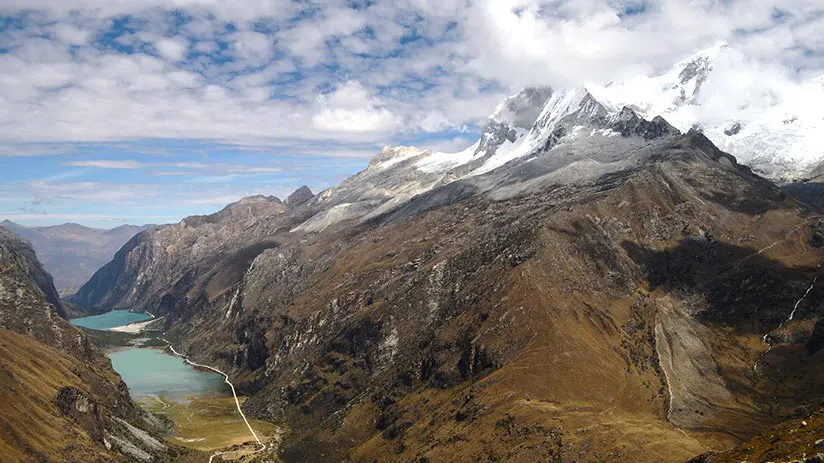
| Duration | 4 Days / 3 Nights |
| Extension | 50 kilometers or 31 miles |
| Elevation | (4,000 m. / 1,219 ft.) |
| Difficulty | Moderate |
A. Route
The Santa Cruz trek is a fascinating and economical four-day option located in Huascaran National Park, in the middle of Cordillera Blanca (White Mountain Range), the center of Peru. The hike surrounds the Santa Cruz snow (6,259 m./ 20,534 ft.) and is extended by 50 kilometers between Vaquera town (3,700 m./ 12,139 ft.) (its start point) and Cashapampa (the end).
The hike begins in Huaraz City (8 hours by bus from Lima north). From this point, the visitor must take transportation until Vaquera, where there will be 4 to 7 hours of moderate trekking daily.
As we mentioned, the route crosses the Cordillera Blanca, a sector known for its imposing snow-capped peaks at a high altitude. Spectacular glaciers, towering mountains, and deep blue lakes characterize the hiking trail. Remember that much of the hike occurs at over 4,000 meters, so acclimatization is mandatory.
Most hikers tackle the route in four days, but it can be less if you are in shape. It can be done independently, but we recommend you consult our guide for a completely safe trip before taking it.
B. Difficulty
There are few trekkers on the route, for it is perfect for those searching for peace and enjoying nature. Excepting this, the hike is really strenuous the first moments up to reach Punta Union (Union Point pass) located at 4,750 meters. The rest of the route is relatively easy.
C. Interesting points to pass
Cashapampa is a town where visitors can enjoy its hot springs and take a deserved rest. The Arhuaycocha Lake is another great attraction with its bright teal alpine lake located among the Pucajirca and Rinrijirca mountains and the Arhuay glacier.
5. The Vilcabamba
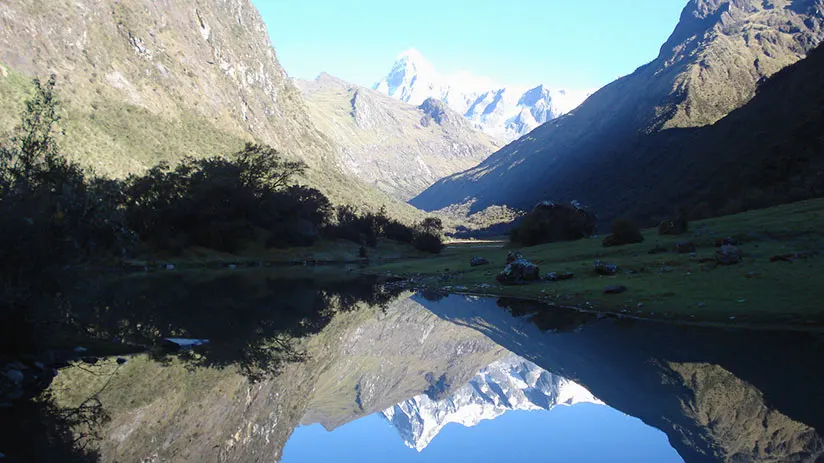
| Duration | 5 Days / 4 Nights |
| Extension | 71 kilometers or 45 miles |
| Elevation | Around (3,800 m. / 12,467 ft.) |
| Difficulty | Moderate |
A. Route
Vilcabamba is known as the lost city of the Incas and was the last Inca stronghold against the threat of the Spanish invaders. Therefore, this hike allows you to explore the ruins of one of the last shelters of the Incas during Spanish invasions.
First, to get to Vilcabamba, it is necessary to travel from Cusco by car up to Huancalle (7 or 8 hours from Cusco north). From this point, the hike will begin, heading to 2 beautiful Inca ruins, Rosapata and Vitcos.
After that, you’ll continue the hike, passing by the top of mountains, valleys, and tropical jungles. Exuberant foliage typical of the Peruvian jungle will be the scenery of your hike. Natural formations of rocks, the Chontabamba River, and the fantastic. Espiritu Pampa Ruins will be your final reward. Did you know that Vilcabamba was the actual Inca city lost in the jungle? That’s right, Hiram Bingham, when trying to discover it, came across Machu Picchu.
Being a slightly underrated hiking trail, it can look quite “empty” compared to other trails. But don’t let this put you off. It is a perfect opportunity to challenge yourself and get to know one of the most beautiful sectors of Peru. After visiting Vilcabamba, you’ll return to the civilization through Kiteni town. The hike lasts 5 days, with walking time from 4 to 7 hours per day, and an extension of 71 kilometers approx. And has an elevation of around, (3,800 m. / 12,467 ft.).
B. Difficulty
The hike can be considered moderate, precisely on its second day, when the trekkers reach the highest mountain pass (3,860 m./ 12,664 ft.). From this point, the route constantly declines through the high and tropical jungle. For this reason, this hike is reserved for travelers in excellent or average physical condition.
C. Interesting points to pass
The Collpajasa pass is the first point to arrive at (3,560 m/ 11,679 ft.). Here, you’ll reach an Altiplano, which offers great views of the valley and mountain of Vilcabamba.
The Huayna Pukara is the sector of the real last battle of the Incas against Spanish invaders. Visiting it with a guide will be a priceless experience. The Espiritu Pampa is an area that has Inca buildings still covered by vegetation, and the Siete Tinajas waterfalls will refresh the last part of your journey.
6. Salkantay
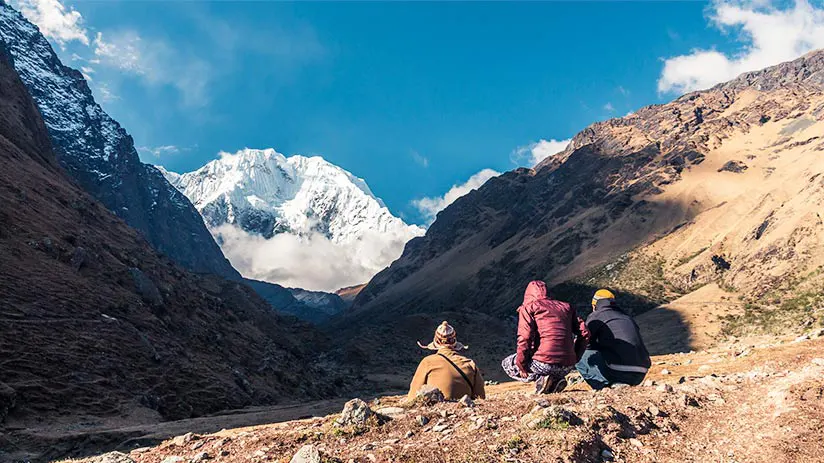
| Duration | 5 Days / 4 Nights |
| Extension | 70 kilometers or 44 miles approx. |
| Elevation | (4,500 m. / 14,763 ft.) |
| Difficulty | Moderate |
A. Route
If you are not a fan of crowds, search for something cheaper, but with more kilometers of adventure than the Inca Trail, the Salkantay Trek will give you all you are looking for. This route is the second most visited hiking trail after the Inca Trail, and it is an excellent alternative if you don’t get tickets for the Inca Trail. The route surrounds the Salkantay snow (6,271 m./20,574 ft. ) and lasts 5 days and 4 nights, with an extension of 70 km approx.
The route begins in Soraypampa, near Mollepata (134 km east of Cusco). The views are fantastic. You’ll cross Andean valleys and snowy passes and enjoy the charm of a beautiful glacial lagoon called Humantay.
The second day is the most vital part. You’ll climb to Salkantay Pass (over 4,600 m./ 15,091 ft.) to get the best postcards of Salkantay snow. Afterward, you’ll descend, crossing cloudy forests and lush vegetation and heading to the warm jungle.
This is the achievement of doing the Salkantay hike, being able to experience the weather change from Sierra to Jungle. Because you can pass from the dry and cold weather of the Peruvian Andes (4,500 m./ 14,763 ft.) to the humid and warm climate of the Peruvian Jungle (1,800 m. / 5,905 ft.), you will feel this extreme change of weather in one route. In the last few days, you’ll see unique local fauna, with the possibility of enjoying warm hot springs located in Santa Teresa town, getting to Aguas Calientes town, and, finally, to Machu Picchu.
B. Difficulty
The hike is located at a great altitude, but it is well-signed and can be done independently without requiring entrance tickets. The only substantial part is climbing to Salkantay Pass on the second day. For this reason, this hike is considered Moderate. Those with some experience hiking and who are in good physical condition will enjoy this hike. The dry season (from April to November) is the best time to visit Peru.
C. Interesting points to pass
Salkantay Pass, with its great views of the Snowy, is an essential point in your journey. The high jungle has an exotic fauna of tarantulas, snakes, ants, and more.
The Humantay Lagoon with its crystal clear water resembles a large natural mirror. Almost arriving at our destination, Santa Teresa town offers us its hot spring to rest and enjoy. And, as an ice on the cake, Machu Picchu.
7. Laguna 69
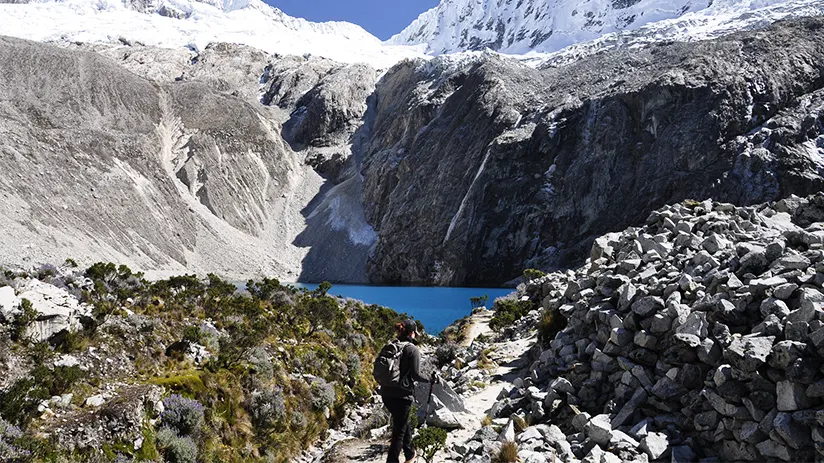
| Duration | 1 Day |
| Extension | 6 Kilometers or 4 miles |
| Elevation | Around (4,200 m. / 13, 779 ft.) |
| Difficulty | Easy |
A. Route
Contrary to what you might imagine from the name, this walk does not last 69 days. It receives its name from the lagoon it surrounds because it is the sixty-ninth lagoon in a list of more than 800 high Andean water bodies of the Cordillera Blanca. For this reason, both the lagoon and the hiking route are located in the center of Peru, specifically inside Huascaran National Park, in Peru center.
The hike lasts 1 day (6-7 hours), with no overnight stay. And it has an extension of 6 kilometers. The route runs along the shores of Laguna 69, passing beautiful paths, towering waterfalls, bluish lakes, giant trees covered by moss, incredible peaks, and quaint meadows.
The unique factor is the altitude because the route goes over (4,500 m./ 14,763 ft.). You’ll have to depart from Huaraz (400 km from Lima North) to get there. Once you arrive there, you can take public transport to Yungay City (56 km more from the north of Huaraz).
From this town, you’ll have to go to La Cebolla, inside Huascaran National Park, which is the starting point and final point of this fantastic hike.
B. Difficulty
The path is a gentle ascent for most of the route. The last 30 or 40 minutes of walking are steeper and more difficult curves. Therefore, hikes can be considered to be at an easy to moderate level.
In the same way, good physical condition and good previous acclimatization are required. Moreover, hiking lasts from 6 to 7 hours, so it is highly recommended that you start this wonderful route very early. Also, it can be done independently. However, you’ll need an entrance ticket ($19) to purchase in the same Cebolla place.
C. Interesting points to pass
The same Lagoon 69 (4,600 m./14,028 ft. ) is quite a spectacle. Its crystalline and turquoise waters, protected by snow-capped mountains and glaciers and beautiful green meadows, will transport you to the Swiss landscapes from magazines!
8. Humantay Lake
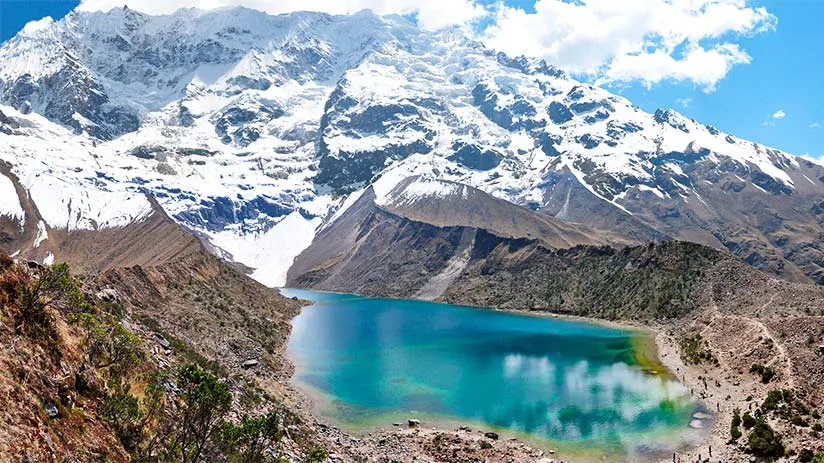
| Duration | 1 Day |
| Extension | 10 kilometers or 6 miles |
| Elevation | From (3,870 m./ 12, 696 ft.) to (4,200 m./ 13,779 ft.) |
| Difficulty | Moderate |
A. Route
Humantay Lake, along with Machu Picchu and Rainbow Mountain, is the new treasure that Cusco offers. Its crystal clear turquoise waters, in a calm pond, sheltered under the slopes of an impressive snow-capped mountain called Salkantay, and a mysterious fog that always covers it in the mornings will make the climb to its banks worthwhile and make a wish. This is a hike of 1 day and forms part of the Salkantay hike.
It begins taking transportation from Cusco to Mollepata. Once you arrive at this little town located 247 km from Cusco East, the fun will begin. Usually, the tour begins with a hearty breakfast in any tourist restaurant situated in the place.
After that, the journey continues, beginning the hiking and heading to Soraypampa base camp (Used as a first camp zone in the Salkantay hike 5D/4N) The hike until this point lasts 5 hours and has an extension of 27 kilometers. Once arrive at Soraypampa, you will begin the climb up heading to the lagoon, it is 2 kilometers more of ascension in 1 hour and a half of hiking (one way).
Finally, you will arrive at the Humantay Lagoon (4,200 m./ 13,779 ft.), where you’ll appreciate its beauty and giant snow like Humantay and Salkantay that protect it. On its shores, you can build a small tower or house with the loose stones that are around the lagoon (Apacheta in the Quechua language), making a wish and praying to the Apus (Deities in the form of mountains or snow-capped mountains).
It is said that your wish will be made real if your Apacheta remains standing as long as possible. So the better you put it together, the better. The return is a descent of 1 hour and a half more to Soraypamapa. In the base camp, you will take public transportation to Mollepata to enjoy a delicious lunch. In this town, there is much public transportation to return to Cusco. This hike can be realized independently; however, we recommend doing it with a tour guide.
B. Difficulty
The hike is moderately difficult, but its location (at a high altitude) and parts of excessive inclination (almost reaching the lagoon) can make it challenging.
C. Interesting points to pass
The trek is a real adventure for those who want to feel liberty, peace, and the echoes of the Andean mountains. Once you arrive at Humantay Lake, you will think that the slope walked will have been worth it. Don’t worry about the return; the descent walk is more accessible and lasts one hour to Mollepata. There is a lot of transportation that departs to Cusco every hour.
Regarding the food, Mollepata has many tourist restaurants serving various Peruvian dishes. We recommend taking the tour through a travel agency and wearing snow clothes for the adventure.
9. Rainbow Mountain
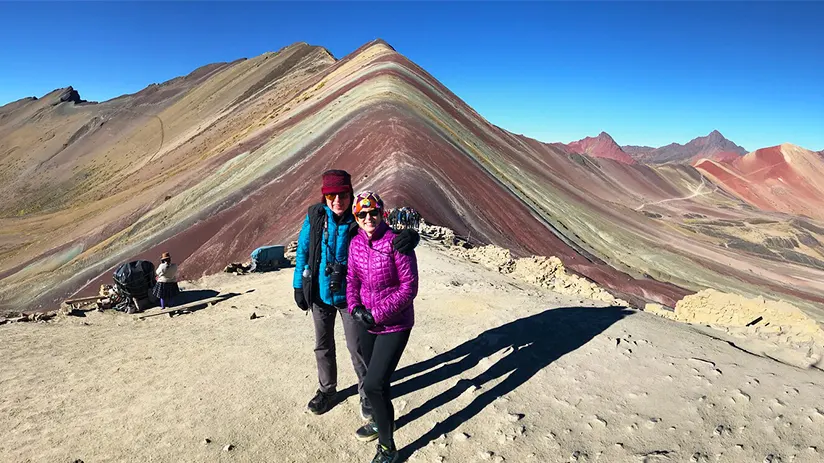
| Duration | 1 Day |
| Extension | 7 Kilometers or 4 miles |
| Elevation | From (4,400 m. / 14,435 ft.) to (5,000 m./16,404 ft.) |
| Difficulty | Challenging |
A. Route
As we mentioned, Rainbow Mountain (5,020 m./ 16,469 ft. ) comprises soils with abundant minerals distributed linearly. The minerals make contact with the cold breezes of the mountains, the rains, the extreme sun rays, and even the snow (In Winter) and produce a variety of colors.
It is one of the new charms with Cusco, besides Machu Picchu and Humantay Lagoon. It was discovered in 2005 when the snow of the snowy Vinicunca began to recede due to the effects of global warming, showing intense colors on its top. In the same way as Humantay, the rainbow mountain hike form part of the longest trek called the Ausangate hike (6D/5N).
If you are planning any vacations in Peru, the Rainbow Mountain Trek is your must-see destination. To get there, you will have to take direct transportation from Cusco to Paucarpata (Which lasts two hours and a half / Through a travel agency) and after to Qheshiuno Local Community (Both zones are located southeast of Cusco).
If you want to make the hike yourself, you must take public transportation from Cusco to Sicuani (it lasts two hours) and then take another transport until you reach the Qheshiuno community. The Pickup time from Cusco will be very early, 03 or 04 a.m.
From the community, we will begin this fantastic hiking. The trek lasts 03 hours, and you will ascend through stony and rough paths (Wearing trekking shoes and pants) is recommended. Finally, on the top of Vinincunca Mountain, you will see this marvel, a complete hill covered by distinct colors in front of look into.
It is recommendable doing it with a tour guide because at this point, he will explain the geographical and mineral composition of the soil and tell you a little about global warming and its consequences. The return is by the same way: a descent of 3 hours to Qheshiuno and after transportation to Paucarpata. There, you can take advantage of lunch in one of the many tourist restaurants or go directly to Cusco.
B. Difficulty
The footpath is plane (most of the time) and not very large. However, the last section is usually quite steep. Also, watch out for the brutal winds at the moment of your photos once arrived in Vinincunca, remember, you will be over the top of a mountain. For the great altitude (5,000 m./ 16,404 ft. ). (Almost a few meters below Everest Base Camp!), the brutal cold winds, and the slope in the last sections of the trail, this hike can be considered strenuous.
C. Interesting points to pass
The attraction is the mountain of 7 colors. However, the experience of the same hiking is unique. You’ll pass by Andean green valleys, charming local communities, and an adorable group of Alpacas to finally get to the Vinincunca top. Impressive colors will welcome you, waiting for the perfect postcard!
10. Huayhuash Trek
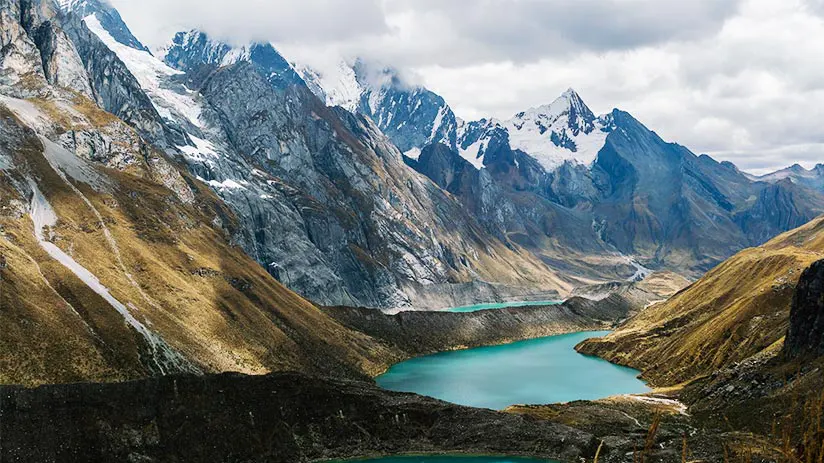
| Duration | 10 Days |
| Extension | 180 Kilometers or 112 miles |
| Elevation | From (3,400 m./ 11,154 ft.) to (5,300 m./ 17,388 ft.) |
| Difficulty | Challenging |
A. Route
The Huayhuash trek is one of this country’s most extreme hiking routes in the Cordillera Huayhuash. The route is inside Huascaran National Park, in the central Andes of Peru, north of Lima. The hike is circular and surrounds the Huayhuash mountain range for 8 to 10 days, covering over 180 kilometers or 112 miles of extension and passing by 8 high points.
This hike in Peru is highly challenging for those who want to experience physical exertion and satisfaction on each day of trekking. You will pass beautiful landscapes on slopes of snowy mountains like Siula Grande (over 6,344 m./ 20,813 ft.) or Yerupaja (over 6,617 m./ 21,709 ft.).
Besides, the Huayhuash hike has the reputation of being the most challenging hiking in the Andes and one of the best hiking circuits in the world. Also, in some parts of the route, you will pass over (4,000 m./13,123 ft.), even reaching (5,000 m./ 16,404 ft.).The route begins in Cuartewain Point and finishes in Llamac Point.
B. Difficulty
It can be done independently; however, due to the hike’s elevation, the road’s desolateness, and the strenuous points to pass, we recommend doing it with an expert tour guide. It is a strenuous hike; the best time to hike is in the dry season (between May and September). Good physical condition, a high level of hiking experience, and a persevering spirit are the characteristics of someone who wants to do this hiking.
C. Interesting points to pass
Along the way, you will be able to see glacial lakes of unreal blue tones and Andean peaks covered in the purest snow, in addition to the fantastic fauna and flora of the place.
11. Colca Canyon
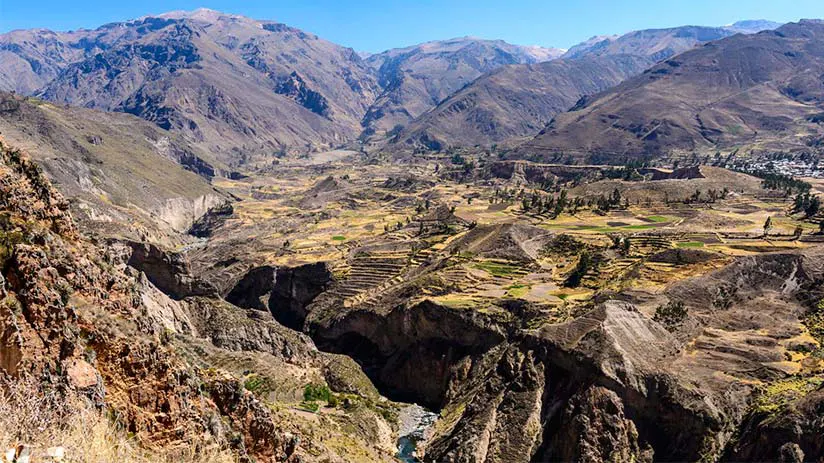
| Duration | 2 Days / 1 Night |
| Extension | 24 Kilometers or 15 miles |
| Elevation | From (2,200 m./ 7,217 ft.) to (3,500 m. / 11, 482 ft.) |
| Difficulty | Challenging |
A. Route
Hiking in Peru has two principal representatives in the south: the Inca Trail in Cusco and the Colca Canyon trek in Arequipa. The last one is developed in the fourth-deepest canyon in the world (3,270 m. of depth). Colca Canyon is located three hours by bus from Arequipa’s northwest face. To get there, you will pass by Chivay, a quaint town. If you want to enjoy a good breakfast before trekking, there you will find some good restaurants.
The Colca hiking attracts more than 120,000 visitors annually because it can be done independently. However, we always recommend being accompanied by a tour guide or a travel agency. The area is famous for its incredible views, the overflying Colca Canyon condors, the high viewpoints, hot springs, and much more.
The trek lasts two days and includes an overnight stay in Sangalle, a local town located in the canyon’s depths, one side of the Colca River (18 km of extension on the first day and 6 km on the second day).
It begins from Pampa San Miguel’s lookout. From this point will begin, the hike downhill will begin. The visitor will have to go downhill until the same canyon abyss, more than 3200 meters of descending; watch out for when walking on small ravines, slippery stones, and tricky slopes.
You’ll pass by Yanque, a charming town where those who didn’t have breakfast can do it. In the same way, the hike passes by the La Cruz Del Condor (Condor cross) viewpoint to appreciate the overflying of this majestic Andean vulture. The descent lasts 5 or 6 hours.
Once in Sangalle Oasis, you will rest in its well-equipped different lodgings and rest pools. No camping is necessary. The second day is the most demanding trek: 2 or 3 hours of a challenging climb to Cabanaconde Town (3,287 m./ 10,1878 ft.) to get out of the canyon. This climbing ascent has more than (1107 m./ 3637ft.).
B. Difficulty
The hike goes from moderate to strenuous due to its significant elevation and the steep climb on the second day. Also, the hours to start the hike are very early, from 4 to 5 am.
C. Interesting points to pass
The high points here are Los Volcanes Salinas lookout and the viewpoint of Aguada Blanca National Reserve. Getting to the top of the canyon and the physical effort will have to be worth it.
12. Huchuy Qosqo
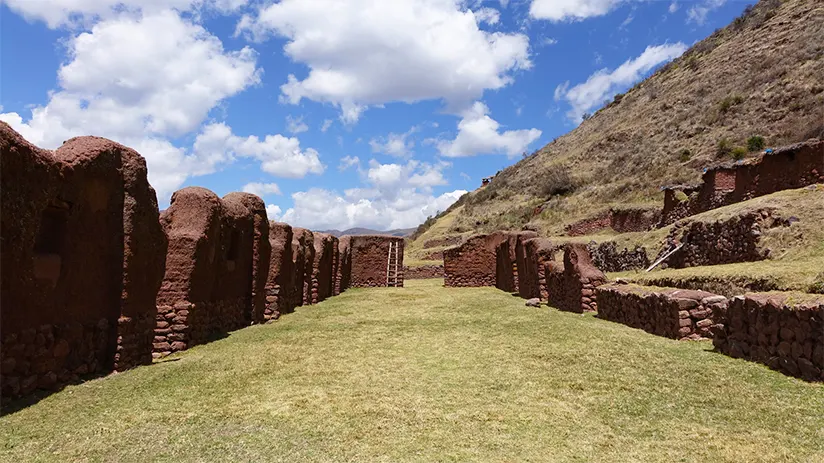
| Duration | 2 Days / 1 Night |
| Extension | 16 kilometers or 10 miles |
| Elevation | From (2,900 m / 9514 ft) to (4,250 m/13,943 ft) |
| Difficulty | Moderate |
A. Route
Huchuy Qosqo, or the Small Cusco (in the Quechua language), was a Real Hacienda belonging to Viracoha Inca (the eighth regent in line of succession) and built around 1420 A.C. The complex stands out for its houses, buildings, an 800-meter irrigation channel, and a 40-meter enclosure with doors and ceremonial niches.
The complex is located at (3,650 m/ 11,112 ft). And 40 kilometers north of Cusco, in the Sacred Valley of the Incas. There are many routes that take 1 and 2 days to get there. The 1-day hikes usually start from Patabamba, Chinchero, or Tauqa town, with slight ascents. Passing by the Huchuy Qosqo Ruins and finishing on the other side, Lamay town, which had previously had a very steep descent. It is 10 hours of hiking, approx.
The hiking of 2 days and one night starts in the north Cusco archaeological site of Tambomachay. You will pass by green valleys, awesome hills, and charming lagoons. The hike with a maximum altitude of (4,300 m/ 14,107 ft ). It will pass by Tambomachay Valley, three high points, and make a stop in Ccauca, stop to get unique postcards, you’ll appreciate the Qeullacocha lagoon and its excellent waters and finally, you will arrive at Pacamraca community campsite.
The following day, you will get to Huchuy Qosqo ruins to explore the complex (If you are accompanied by a tour guide who can explain the history of this center, it will be better). The hiking can be done independently, but you must buy an entrance before.
Finally, on this second day, you’ll begin the downhill climb to Lamay town. The first day’s hike is 6 hours, and the second day’s is 5 hours.
B. Difficulty
The hike is considered moderate to challenging. Due to its three high points to pass the first day, after that, the hike is coming to mild.
C. Interesting points to pass
The three high points are the Abra Sicllajasa (it will bring you perfect views of beautiful mountains and Andean creeks), The Challu Chalu Pass, which will allow you to appreciate charming Andean lagoons, and the Rumicruz Pass, which will offer you perfect views of the Sacred Valley.
The Laguna Queullacocha will be waiting for you in the afternoon of the first hiking day. Usually, you can enjoy a delicious lunch with the lagoon as a background (if you take the Travel Agency services). The ruins of Huchuy Qosqo are a trip back in time; walking through their houses, temples, and esplanades, with beautiful views of the Sacred Valley of the Incas, will be priceless.
“THE MOUNTAINS ARE CALLING AND I MUST GO”
Peru is, without a doubt, a country made for hikers, and you can travel safely in Peru. Among so many hiking trails to choose from, we select the 20 most popular ones. But keep in mind that they are not the only ones to enjoy, there are many routes already unexplored. However, we hope this list has been helpful when choosing a hike to your liking. Some of these are not that crowded, and you will have the complete experience to enjoy of tourism in Peru and its charming nature. The team of Machu Travel Peru wishes you an incredible experience and that you enjoy all the splendor of Peru, the magic Inca Andean country.